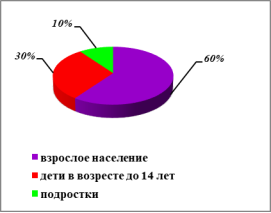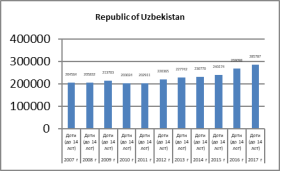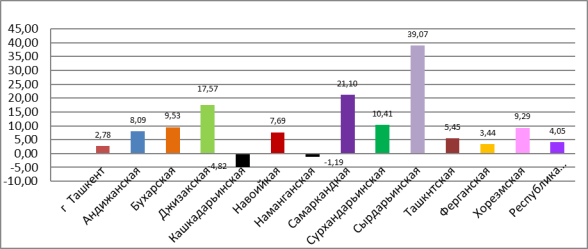In order to introduce pharmaceutical care in the Republic of Uzbekistan, the statistics of diseases of ophthalmologic patients has been studied, for 2007–2017. in the world and in the Republic of Uzbekistan. It is shown that according to WHO estimates about 1.3 billion people in the world live with some form of visual impairment.
Approximately 80 % of all visual impairment cases occurring in the world are considered preventable. Most people with visual impairments are in the age group over 50 years old. It has been established that the number of patients with diseases of the eye and adnexa in Uzbekistan over the past 10 years has increased by 44.7 %, the annual average increase was 3.9 %; high annual average growth is observed in the Syrdarya region and negative growth in the Namangan region; an increase in patients with diseases of the eye and adnexa in the city of Tashkent is due to an increase in the incidence among children, in the Andijan, Tashkent and Fergana regions, an increase in the number of patients is observed due to the adult population, and in Bukhara, Djizak, Navoi, Samarkand, Surkhandarya, Syrdarya and Khorezm regions — at the expense of teenagers.
Keywords: ophthalmology, statistics, pharmaceutical assistance.
In recent decades, a gradual transition from drug care to a wider professional activity, pharmaceutical care (FC), has become noticeable in world practice. In accordance with the 1998 declaration, most countries are introducing the concept of FC into the structure of health care. Each state uses a model that takes into account its national specifics. If in the US the most common model of OP is for hospital and clinical pharmacy, then European countries have a pharmacy-oriented model for the population. However, it is common for these models that they are aimed at improving the efficiency and safety of drug therapy, as well as improving patient's quality of life indicators by integrating the efforts of medical, pharmaceutical specialists and patients.
In order to introduce pharmaceutical care in the Republic of Uzbekistan, we studied on the example of ophthalmic patients, disease statistics for 2007–2017. in the world and in the Republic of Uzbekistan
The World Health Organization estimates that about 1.3 billion people in the world live with some form of visual impairment. As for far vision, mild visual impairment is observed in 188.5 million people, moderate to severe — in 217 million, while 36 million people are affected by blindness [1]. As for near vision, 826 million people live with this kind of visual impairment. Globally, the main causes of visual impairment are unadjusted refractive errors and cataracts. Approximately 80 % of all visual impairment cases occurring in the world are considered preventable. Most people with visual impairments are in the age group over 50 [2].
An analysis of statistical data for the Republic of Uzbekistan showed that more than 60 % of patients with diseases of the eye and adnexa occur in the adult population, and about 30 % in children under the age of 14, 10 % of all patients with diseases of the eye and adnexa occur in adolescents. The distribution of patients by region of the country is shown in Figure 2.

Fig. 1. Distribution ophthalmic patients by age categories

Fig. 2. Distribution of ophthalmologic patients by regions of the Republic of Uzbekistan
Most of the ophthalmologic patients are registered in Tashkent and account for about 16 % of all patients; 2.6 % in the Navoi region
In Uzbekistan in 2017, about 1 million people were registered with a diagnosis of eye and adnexa diseases, and its growth is on average of 3.5–5.2 % (Fig. 3). Analysis of the growth of patients over the past 10 years showed spasmodic dynamics (Fig. 4). So, if in 2008 the increase was + 4.23 % in relation to 2007, then the indicator goes down to 2011 and is — 7.2 % less than the previous year. A sharp increase in diseases of diseases of the eye and adnexa is observed in 2012 (+ 12.6 %), then until 2014 there will again be a decline in diseases. The peak of growth was 16.7 % in 2016 (Fig. 4).

Fig. 3. Dynamics of ophthalmic patients in 2007–2017

Fig. 4. Analysis of the average increase in ophthalmologic patients for 2007–2017
On average, the annual increase is 3.9 %. However, over 10 years the number of patients has increased by 44.7 %.
For a more detailed analysis, we conducted a study of statistical data on diseases of the eyes and adnexal apparatus in the regions of the republic.
The results of the analysis also showed spasmodic dynamics. The highest growth in the regions of the country is observed in the Syrdarya region (20.85 %), a negative increase in the Namangan region (-5.0 %). Above the average, growth in Andijan, Kashkadarya, Samarkand, Tashkent and Khorezm regions is observed (Fig. 5.)

Fig. 5. Analysis of the growth of ophthalmological patients in the regions of the Republic of Uzbekistan
Next, we analyzed the diseases of the eye and adnexa by age categories. Figure 6 shows the growth dynamics of the disease in children under 14 years of age. The results of the analysis showed that in 10 years the incidence of the eye and adnexa among children increased from 2,04564 to 285,787 cases, that is, by 39.7 %, the annual average increase in the republic was 4.4 % (Fig. 6). We also analyzed average growth in the regions of the country. The results of the analysis showed that the Syrdarya region accounted for the largest increase (16.14 %), in the Namangan region the growth of patients with diseases of the eye and the accessory apparatus was negative (-1.04 %), a slight increase (0.36 %) was observed in the Fergana region (rice.7). Growth, higher than the national average, is also observed in Andijan (4.53 %), Jizzakh (9.2 %), Kashkadarya (9.0 %), Samarkand (9.6 %), Surkhandarya (6,98 %) regions and the Republic of Karakalpakstan (5.2 %).

Fig. 6. Dynamics of growth of children with eye disease and adnexa in 2007–2017

Fig. 7. Analysis of the average increase in children under 14 years of age for 2007–2017
The results of the analysis of statistics of diseases of the eye and adnexa among adolescents also shows their growth from 68,939 registered patients in 2007 to 10,9859 cases in 2017. The average increase over the last 10 years was 5.14 %. Peak growth in patients, as well as growth among children, is observed in the Syrdarya region (39.0 %), negative growth in the Kashkadarya (-48 %) and Namangan (-1.2 %) regions. Above the average increase in Andijan (8.1 %), Bukhara (9.5 %), Jizzak (17.5 %), Navoi (7.7 %), Samarkand (21.1 %) and Khorezm regions (Fig. 8).

Fig. 8. Dynamics of growth in the number of adolescents with eye disease and adnexa in 2007–2017
Analysis of statistics among the adult population also shows the largest increase in the Syrdarya region (23 %) and the lowest in the Namangan region (-5.12 %). However, the growth of sick adolescents (2.8 %) in the city of Tashkent is much lower than the increase in patients among children (6.0 %), that is, the increase in patients with eye disease of the accessory apparatus comes at the expense of the child population. In the rest of the country, the opposite is true. For example, in the Andijan, Tashkent and Fergana regions, an increase in patients is observed at the expense of the adult population, while in the Bukhara, Djizak, Navoi, Samarkand, Surkhandarya, Syrdarya and Khorezm regions, an increase in patients with eye diseases and accessory apparatus occurs at the expense of adolescents.
Thus, as a result of statistical analysis of ophthalmologic patients, it was revealed:
– the number of patients with diseases of the eye and adnexal apparatus over the past 10 years has increased by 44.7 %, the annual average increase was 3.9 %;
– high annual average growth is observed in the Syrdarya region and negative growth in the Namangan region;
– an increase in patients with eye diseases and adnexal apparatus in the city of Tashkent occurs due to an increase in the incidence rate among children in the Andijan, Tashkent and Fergana regions, an increase in the number of patients is observed due to the adult population, in the Bukhara, Djizak, Navoi, Samarkand, Surkhandarya, Syrdarya and Khorezm regions— at the expense of teenagers.
References:
- Bourne RRA, Flaxman SR, Braithwaite T, Cicinelli MV, Das A, Joans JB, et al.; Visions Loss Expert Group. Magnitude, temporal trends, and projections of global prevalence of blindness and distance and near vision impairment: a systematic review and meta-analysis. LancetGlobHealth. 2017 Sep; 5(9):e888–97
- Fricke, TR, Tahhan N, Resnikoff S, Papas E, Burnett A, Suit MH, Naduvilath T, Naidoo K, Global Prevalance of Presbyopia and Vision Impairment from Uncorrected Presbyopia: Systematic Review, Meta-analysis, and Modelling, Ophthalmology. 2018 may 9

